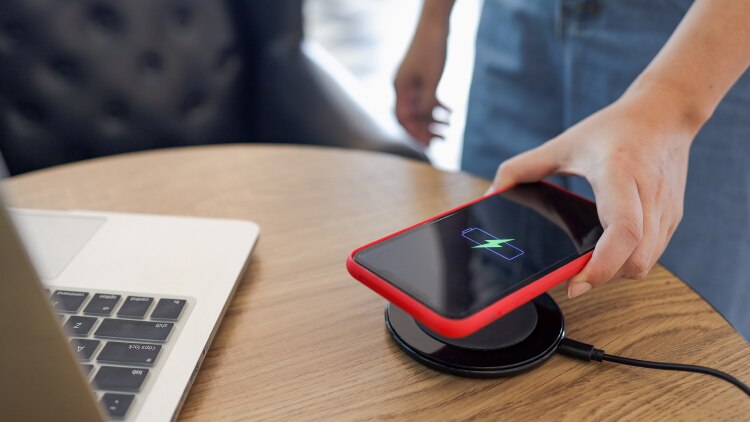

2025 Popular Wireless Charger Shopping Guide & Recommendation
As the popularity of wireless charging increases, new mobile devices launched in recent years are also now supporting wireless charging. But what are the principles and advantages behind a wireless charger? What should you be aware of before buying one? Here is a guide from Fortress with product recommendations from Adam Elements, Belkin, Momax and Verbatim。
The principle behind wireless charging
Wireless charging uses a non-contact medium to transmit power over a distance via metal coils and receivers to provide power to a device.
The dominant wireless charging standard is the Qi standard developed by the Wireless Power Consortium (WPC) widely recognised by the industry. It is a short-range, low-power wireless inductive power transmission interconnection standard that can be applied to mobile devices such as smartphones. It is a convenient wireless charging method for users.
Advantages of wireless charging
Compared to conventional wired charging, wireless charging is comparatively slower and less efficient. However, wireless charging offers the following advantages over traditional charging methods.
1. Your device is fully charged at all times
This is essential, for example, for motorists. Many drivers use the navigation software on their smartphones to assist them in driving. But keeping the GPS function switched on for long periods of time can be very power-hungry and run the battery down quickly. So a wireless charging car mount not only allows the driver to use his phone’s auto navigation system, but also charges the phone at the same time.
2. No need to plug and unplug the charging cable frequently
Exposed parts of the phone such as the screen and charging port are more prone to damage than the battery. This is because constantly plugging and unplugging the charging cable can resulting in poor contact with the charging port. Switching to wireless charging prevents premature damage to the charging port and prolongs the life of your phone.
3. Compatibility with different types of devices
Different brands of mobile devices have their own systems and standard charging connectors. But you don’t have to worry about this with a wireless charger. If you own all sorts of devices, you can enjoy the convenience of a universal wireless charger rather than having to change the charging cable every time you charge a different device.
Types of wireless chargers and features
A flat type of wireless charger is for mobile phones and headphones that support wireless charging. Choose one with a non-slip design to avoid the device sliding off the charging surface. Some models come with a storage option to help keep your desk tidy and organised.
• Wireless Charging Stand
A wireless mobile phone stand for desktops helps you charge your phone during operation. Choose a model with an adjustable angle and a horizontal handle to enjoy easy manoeuvring during daily chores, leisure or watching videos.
• In-car wireless charging cradle
In-car mounts with a wireless charging function allows the phone to operate the smart navigation software while charging at the same time. Find out how the product is mounted (usually by an adhesive or by clipping the cradle to the air outlet). Select according to your driving habits.
• Wireless power source
With wireless charging, you no longer need to carry a charging cord when you are out and about. Some models support multi-device charging, allowing users to use both wireless and wired charging functions at the same time.
Points to note when choosing a wireless charger
A Qi certified wireless charger does not necessarily mean increased charging efficiency or speed. However, a WPC certified charger has been tested to be safe, reliable and compatible with other Qi-enabled devices.
2. Charging efficiency
This depends on your mobile device. For example, Apple phones prior to the iPhone 12 only supported the Qi protocol with a maximum power of 7.5 W. The iPhone 12 is now equipped with MagSafe, which allows charging of up to 15 W and makes sure the phone is attached right at the middle of the charger. Be aware of the charging efficiency supported by your device before you buy.
3. Safety protection
The safety features of a wireless charger are very important especially its heat dissipation function. Some wireless chargers are equipped with a separate fan to ensure ample heat dissipation. Choose models with other protection features such as a foreign object alert function; short circuit, overcharge and overcurrent prevention to ensure safe charging.
4. Number of built-in coils
At present, 1-3 coils are the norm for most wireless chargers. The higher the number of coils, the larger the charging area and easier it is to charge the device. Be aware of the position of the charging chip on your device to avoid power wastage during charging.
5. Non-slip design
Choose a charger made from non-slip material to avoid wear and tear and to keep the bottom of the charger stable when placed on a smooth table or other flat surfaces.
6. Charging socket
Check whether the charger comes with its own brand charging socket. A rechargeable socket makes everything more convenient and because it is compatible with its own brand it guarantees safer use. If you need to use your own charger, check the specs of the charger to see if it can support high-power wireless charging. For example, Apple's most popular 5W charging plug, which comes with the phone, does not support fast wireless charging.
7. MagSafe magnetic charger
iPhone 12 uses MagSafe, a design that concentrates 36 magnets inside to make sure the phone attaches to the centre of the charging port without touching the microphone on the edge of the device. This means that wireless charging will not interfere with the normal operation of the microphone and speakers, allowing users to conduct phone or video conferencing with peace of mind. Last but not least, it is best to use MagSafe for wireless charging on its own or in the MagSafe case to avoid weakening the magnetic contact.

